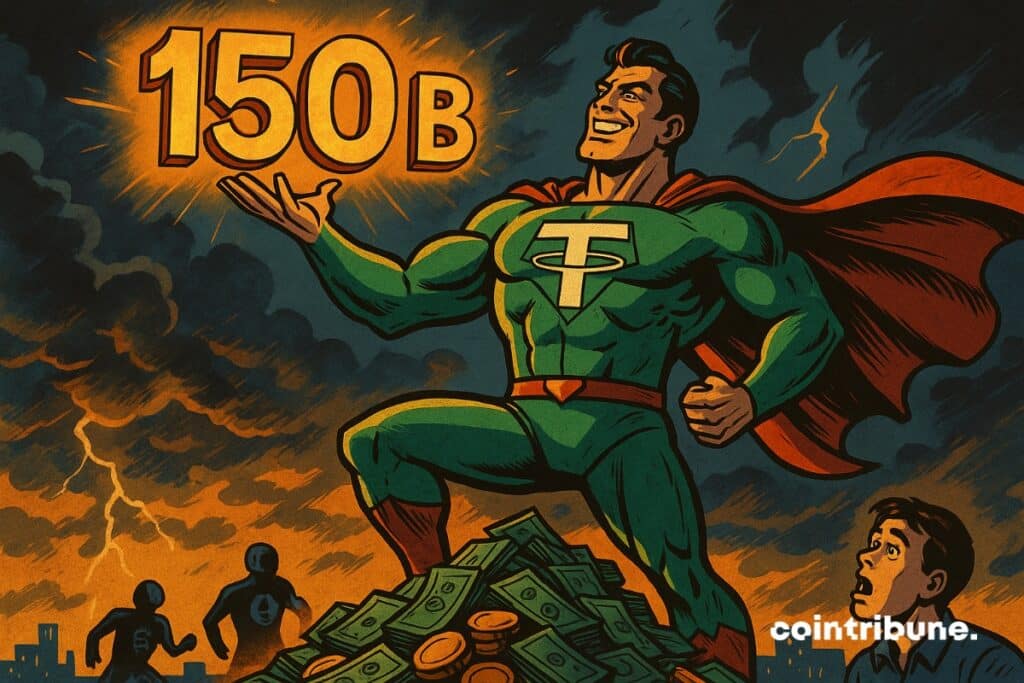Tether Smashes $150B Market Cap—Because Nothing Says ’Stable’ Like Exponential Growth
Tether (USDT) just bulldozed past $150 billion in market capitalization—proving once again that crypto’s favorite ’stable’ coin plays by its own rules. The USD-pegged token now accounts for nearly 70% of all stablecoin transactions, despite regulators’ side-eye.
The irony? A ’stablecoin’ growing faster than most speculative assets. Meanwhile, traditional finance still can’t decide if this is genius or a time bomb.
Love it or hate it, Tether’s dominance is rewriting liquidity rules—while banks scramble to keep up. Just don’t ask where the reserves are parked this week.

In Brief
- Tether reaches $150 billion capitalization, strengthening its dominance with 61% of the global stablecoin market.
- USDT establishes itself as a reference asset, with growing adoption, notably through 30 million active wallets.
- Stablecoins attract interest from tech giants like Meta while posing major regulatory challenges.
Tether surpasses 150 billion dollars: sustained growth
On May 12, 2025, Tether crossed a symbolic threshold with a market capitalization exceeding 150 billion dollars. This 36% year-over-year increase reflects growing confidence from crypto users and institutions in stablecoins as a liquidity solution. The number of active wallets jumped from 19.6 to 30 million in one year, confirming USDT‘s deepening integration into daily use.
This momentum is driven by persistent volatility in crypto markets, encouraging actors to seek stable digital assets while facilitating cross-border transfers and trading on decentralized platforms.
USDTUSD chart by TradingViewDominance of the stablecoin market and expansion strategy
Tether now holds 61% of the global stablecoin market, far ahead of its main competitor, Circle’s USDC, which captures nearly 25%. This leadership is strengthening as the company announces the upcoming launch of a dollar-backed stablecoin specifically aimed at the US market. This product aims to bypass regulatory barriers that limit USDT in some jurisdictions.
In parallel, Tether is deploying a lobbying strategy in Washington to influence legislative debates, particularly around the STABLE Act. This MOVE shows a clear intent to anchor USDT within the US legal framework while maintaining its international base.
Perspectives and implications for the crypto ecosystem
Tether’s achievement of a historic record could accelerate stablecoin adoption in the digital economy. Originally designed for trading, these assets are evolving towards new uses:
- Payment tools for digital platforms;
- Savings solutions in unstable economies;
- Instruments for cross-border value transfer;
This progress comes with growing regulatory challenges, particularly in the United States where lawmakers are scrutinizing the systemic impact of these assets. The rise of stablecoins highlights the need to balance:
- Technological innovation;
- Financial stability;
- Clear legal framework.
Compliance by issuers like Tether with future standards will be decisive for their long-term legitimacy.
Growing interest in stablecoins, shown by the recent initiative of Meta potentially integrating them into its monetization, confirms their key role in digital finance. As Tether reaches a historic peak, one question arises: will these assets shape a new monetary order, or accelerate global regulatory divides?
Maximize your Cointribune experience with our "Read to Earn" program! For every article you read, earn points and access exclusive rewards. Sign up now and start earning benefits.

